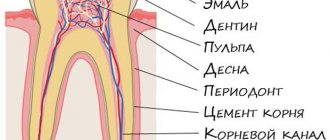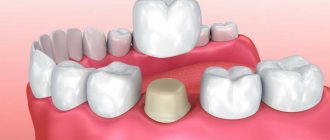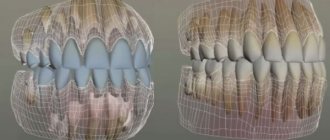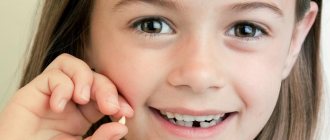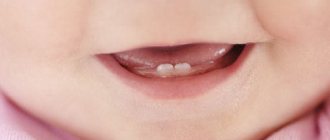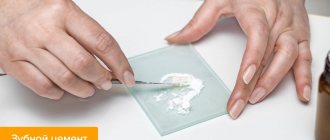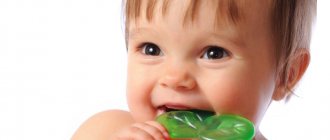Author: Brodsky Sergey Evgenievich Deputy Chief Physician, Candidate of Medical Sciences in the specialties: dentistry and medical microbiology How does the eruption, loss, treatment and removal of baby teeth proceed in children? How many baby teeth do children have normally? How to treat caries, pulpitis and periodontitis of baby teeth in a child and how much does it cost? Read more...
- Baby teeth and age
- Which teeth are baby teeth and which are not?
- Eruption of baby teeth in children
- Baby tooth hurts, how to treat?
- Cost of treatment of baby teeth
Deputy chief physician
Brodsky Sergey Evgenievich
Sign up for a free consultation
+7
Baby teeth and age
Why do children need baby teeth? The sequential appearance and replacement of baby teeth with permanent ones is a necessary stage in the development of organs and tissues of the maxillofacial area. In other words, it is the growth of the skull and jaws that correlates with the appearance of baby teeth in children, and their pattern of eruption and loss allows specialists to track and predict both developmental defects and the normal course of events.
Accordingly, during the first 12 years of life, when baby teeth change, they perform several important tasks:
- Provide phonetics and diction skills during speech development
- Provide chewing load and the required metabolism in growing children's jaws
- Creates and maintains a child's bite until a permanent bite appears
- Provide “navigation” for the eruption of permanent teeth at the right time and in the intended place without displacement or delay.
Accordingly, early loss of baby teeth is an extremely undesirable development of events. Baby teeth, photo
Milk teeth in children: order of eruption, caries, pulpitis, removal
The appearance of primary teeth in a child is a natural mechanism that makes it possible to switch from breast milk or artificial feeding to eating solid food.
These teeth are also needed so that the jaw apparatus of children develops anatomically correctly, and they also provide a constant “chewing load for the formation and strengthening of the facial muscles.
Features of care
By following simple rules in caring for your baby’s baby teeth, you can avoid many troubles:
- the first bite should be cleaned with a silicone brush or gauze without using paste and always 2 times a day,
- The pastes that you choose for your little one should be without abrasive bleaching substances, it should not contain fluoride, flavors and dyes,
- it is extremely important to include in the diet foods rich in calcium and phosphorus, for example, milk, cottage cheese, fiber-containing vegetables, exclude sweets and foods with high acidity and dyes,
- The child should drink a lot of clean water - this promotes the secretion of saliva, which in turn prevents the development of bacteria. Do not instill in your child a love for carbonated drinks. Sugar contained in them in record large volumes will inevitably lead to caries.
The condition of teeth is influenced by many factors. It is important for parents to show maximum care and attention to the oral health of their child. If any suspicious spots appear on the enamel, the child should be immediately shown to a specialist.
Video on the topic
How many baby teeth do children have?
The eruption of primary teeth begins in infancy; their appearance has its own patterns and sequence.
Almost simultaneously, teeth appear on the right and left sides of the jaw. The upper incisors, molars and canines erupt later than the lower ones.
Therefore, the formation of baby teeth goes through two main stages:
- orthognathic bite (2 months - 3.5 years), which appears due to slower growth of the lower jaw, when the teeth are located very tightly and their wear is not visible;
- direct bite (3.5-6 years), with the development of signs of tooth wear and the appearance of physiological gaps between them.
Features of primary incisors
The first teeth have their own anatomical features; first of all, they differ in shape. The crowns have serrations on the cutting edge, which form vertical grooves passing through the enamel ridge from the vestibular, that is, the outer side. Gradually, these irregularities are erased due to constant mechanical impact and friction.
Incisors are always larger than other teeth. Their impressive size allows you to evenly distribute the chewing load throughout the jaw. In front they have a more rounded surface than permanent ones. However, in the case of children, their roots are not as long as those of adults, although slightly longer than the roots of the same primary molars.
Teething order
At what age the first baby teeth begin to appear depends on the baby’s health status and his individual characteristics.
There is an average pattern of teething in a child with satisfactory health and normal physical development.
It was compiled based on many years of scientific experience and practical observation of the development of baby teeth in children:
Timing of teething
Upper jaw
Usually the central incisors appear first at 7-12 months of life, then the lateral ones at 8-12 months. Canines and molars can come out in the second and third years of a child’s life. The first in the period from 14 to 22 months, the second in 25-35 months.
Lower jaw
At 5-9 months you can see the eruption of central teeth through the gums, at 8-15 months. they are joined by the lateral incisors. Then comes the formation of canines (15-20 months) and molars (21-33 months).
Why do teeth change?
The human chewing apparatus, from birth to adulthood, goes through the following stages of development for objective reasons:
- The baby takes mother's milk and formula. He does not need many teeth to chew hard foods.
- By the age of one year, 10 baby teeth are quite enough, but it would be useful for parents to know about the age of teething of sixes and other chewing elements.
- After 12 months, complementary foods are introduced and the baby actively chews. The number of jaw elements increases to 20 by 24–36 months. At this age, the baby already has straight A's.
- By the age of 5–6 years, the jaw grows; baby teeth cannot cope with the load from adult food. They are too fragile and thin. Preschoolers, schoolchildren and adults require more strong chewing elements. Milk units are replaced naturally with permanent ones.
On a note! There is no need to pay special attention to the process of changing the bite in children. Nature has provided for everything itself. Teeth loss and teething in preschoolers occurs quickly and painlessly in most cases.
Changing baby teeth
The time at which primary teeth fall out also depends on how correctly children develop physically and whether they have serious abnormalities or illnesses.
In weakened children, teeth erupt, fall out and are replaced with molars later than in completely healthy ones.
In dentistry, an approximate scheme for the loss of baby teeth has been developed:
Upper jaw
- incisors: central - 6-7 years, lateral - 7-10;
- fangs - 10-12;
- molars - 10-12.
Lower jaw
- incisors: central - 5-7 years, lateral - 6-9;
- fangs - 9-12;
- molars - 9-12.
The change of teeth roughly corresponds to the pattern of eruption of temporary canines, incisors and molars. Dentists have also noticed the fact that in girls, all the processes of growth and replacement of baby teeth with molars proceed faster than in boys of the same age.
Possible deviations in terms
Parents should know when permanent teeth should come out. Violations of the timing of bite changes are considered pathological if teeth fall out or erupt much earlier or later than the required time. The earliest age for losing the first baby tooth is considered to be under 5 years of age. Late for the appearance of the first permanent one - 8 years and older. All processes occurring between these periods are considered normal.
If the problem of missing deadlines affects your baby, try to find out the reason. Please note the following most common factors.
Teeth fall out earlier due to:
- jaw injuries;
- congenital formation of malocclusion;
- caries.
Teeth do not erupt for a long time due to:
- rickets;
- infectious diseases;
- heredity.
The baby tooth has fallen out, but the permanent tooth does not grow for a long time due to disease:
- Retentions. There is a rudiment, but the tip does not appear on the surface for a long time. The reason is the wrong direction of tooth growth or deep location in the gum. This pathology is congenital and cannot be cured or corrected. You need to wait for the tooth to grow on its own.
- This problem most often affects the third molars below, incisors and canines above.
- Edentia. The most serious problem is associated with the absence of permanent tooth buds. Chewable elements are missing individually or in entire groups. The child needs the help of a prosthetist. Very rare.
- Impacts. It is difficult for a tooth to break through due to the pressure of the walls of adjacent chewing elements.
On a note! Retention, edentia and impaction are easily detected using x-rays. The rudiments and arrangement of teeth in the gums are visible already in infancy.
Pediatricians and dentists identify several other factors that can provoke violations of the timing of the formation of a permanent bite.
This:
- Gender of the child. In girls, all development processes begin a little earlier than in boys. When a child at 3-3.5 years old has all his milk teeth, and at 13-14 years old he has all his permanent teeth, this is considered normal.
- Features of nutrition of a pregnant, nursing mother and child after the introduction of complementary foods. A lack of calcium, fluorine, iron and other microelements does not bring health to the child.
- Environmental situation in the child’s place of residence. The culprits of the anomalies are polluted water, air, and unsuitable climate.
- Problems with the thyroid gland. Insufficient production of hormones affects the functioning of systems and organs.
- Congenital and acquired pathologies. Children with diabetes mellitus, leukemia, acatalasia, and immunodeficiency are at risk for underdevelopment and delayed formation of permanent dentition.
Baby tooth caries
Is it necessary to treat baby teeth if they disappear naturally sooner or later - absolutely. After all, their earlier loss can cause improper formation of the jaw and impaired diction.
And the development of carious processes often provokes diseases of the gums (gingivitis, cysts and periodontitis) or the oral cavity (stomatitis).
Treatment of caries of primary teeth is considered a necessary and important procedure in dentistry. Filling is carried out using the latest composite materials. To successfully conduct it, the child is distracted with games or uses mild sedation techniques.
To preserve baby teeth with superficial caries, doctors actively use a technique such as silvering . By coating the enamel with silver nitrate, dentists protect teeth from pathogenic microflora. The disadvantage of this method is the pronounced darkening of the enamel after silvering.
Modern analogues of this procedure are remotherapy methods, ICON. With them, the enamel is saturated with minerals, i.e. make it much stronger and it does not change its natural color.
If the teeth are even completely destroyed and they are removed, doctors recommend installing special space holders in their empty place before permanent teeth appear, which avoid mixing and deformation of neighboring teeth and pathological expansion of interdental spaces.
Advanced technologies in pediatric dentistry include the use of crowns or comfortable removable dentures.
How to help a child during teething?
Teething is difficult for both the child and adults. Sleepless nights and drooling, fever and whims - this is how the teething process often goes. How to alleviate your child’s condition and save your nerves? Let's look at proven options.
Mechanical methods (relevant for infants):
Give your baby all sorts of teething aids. Rubber “rodent helpers” can be bought at any children's store or pharmacy; they are filled with gel or liquid specifically for a cooling effect. However, teethers must sometimes be put in the refrigerator and then given to the child to chew on.
Bottles and pacifiers also satisfy your baby's chewing needs. These attributes should be made of high-quality silicone or latex, preferably in an orthodontic form, so as not to disturb the child’s bite.
Finger brushes, which are placed on an adult’s finger for massage in the baby’s oral cavity. In addition, by the strength of your bite you can determine how soon the first tooth will appear.
Massage the gums with a damp gauze pad. A gauze swab must be moistened in cold but boiled water and massaged into the baby’s mouth, this will help relieve itching and cleanse the child of germs.
Medicinal methods (relevant for children of any age)
Of course, it is difficult to cope during such a period without effective drugs, because... Mechanical methods are not always able to relieve pain and are even more powerless in the face of heat. Today, the pharmaceutical market offers a variety of gels, syrups, tablets, ointments and other products for internal and external use. Let's look at the main categories and most popular drugs:
Gels, drops and ointments for topical use that relieve inflammation, destroy pathogenic microorganisms and instantly relieve gum pain - Cholisal, Dentol Baby, Dentinox, Kamistad Baby, Baby Doctor first teeth, Kalgel, Solcoseryl.
Antipyretic, analgesic and anti-inflammatory drugs for internal use - Dantinorm baby (homeopathy), Nurofen syrup (other children's syrups with ibuprofen), Efferalgan syrup (other children's syrups with paracetamol), Dentokind tablets (homeopathy), Riabal syrup.
Antipyretic, analgesic and anti-inflammatory drugs for rectal use - Efferalgan suppositories (other suppositories with paracetamol), Nurofen suppositories (other children's suppositories with ibuprofen), Viburkol suppositories.
Something worth knowing!
Sometimes, a few weeks after the appearance of a permanent or baby tooth, a bluish lump may appear in that place. This is not a pathological phenomenon, it is not accompanied by inflammation and does not pose a danger to the child. This is just an accumulation of bloody fluid that can be released with a light incision if it is too large and bothers the baby.
If there are white and brown spots, stripes, pits or depressions on the first milk teeth, then this is considered a violation. Enamel hypoplasia occurs due to pathology during fetal development in the womb. This disorder appears in children whose mother suffered from constant toxicosis, severe stress, herpes infection, kidney disease, rubella, toxoplasmosis, high fever due to acute respiratory infections and pneumonia.
Pulpitis of a baby tooth
Pulpitis is a common pathology among children. It develops due to the fact that the hard tissues (enamel and dentin) of baby teeth are very thin, so caries quickly “corrodes” them and quickly gets into the tooth pulp.
This disease is a complication after caries or injury. As a result of pulpitis, a purulent process in soft tissues can quickly develop, a fistula may appear on the gum, and the periosteum may become inflamed.
Previously, such teeth were removed, but today there are a number of procedures to cure and preserve them:
- Conservative treatment is used in the early stages of the disease. The carious cavity is opened (drilled out) and treated with antiseptics, then a medicinal paste is placed into it and filled. This therapy is often combined with electrophoresis. In total, the result of treatment is the disappearance of inflammation and preservation of the tooth.
- Surgical treatment (used in advanced stages). Involves partial or complete removal of the pulp, sanitation of dental tissues, filling of canals and teeth.
Structural features
Milk teeth are characterized by their structural features. The following points distinguish them from their older brothers:
- The color of milky enamel has a blue tint,
- crowns are more rounded and lower when compared with permanent units,
- the central incisors on the cutting edge have irregularities similar to jagged edges, which wear off over time;
- they are all significantly smaller in size than those of an adult,
- root canals are wider than those of permanent units,
- on the upper part of the crown, the enamel has a significant thickening, forming a kind of ridge,
- enamel is thinner due to its limited mineral composition,
- dentin is soft,
- premolars are absent, and their place is taken by molars,
- hard tissues are extremely susceptible to destructive carious processes.
All of the above described anatomical and physiological features of the structure of baby teeth are necessarily taken into account if there is a need for their treatment or filling.
Don't panic! A child’s baby tooth falls out, but the root remains - what to do?
All parents sooner or later enter an unpleasant period associated with the beginning of the replacement of their child’s baby teeth with permanent ones. Such changes bring a lot of worry to moms and dads, because most often tooth loss occurs at home and there is always concern that root particles may remain in the socket.
To avoid undesirable consequences, parents are advised to familiarize themselves with all the necessary information long before the first baby tooth falls out.
Hard fabrics
Our teeth are made up of hard and soft tissue. Hard tissues are enamel, dentin, cement. Soft - pulp. The enamel is the outer visible part of the crown, the dentin surrounds the pulp, the pulp is in the cavity of the tooth, and the cementum covers the root. Now let's look at these components in more detail.
Enamel and dentin
Enamel is the hardest tissue of our body as a whole. If we compare it with metal, then its strength will be comparable to the strength of quartz. The main content of minerals is found in hard tissue and reaches the upper limit of 97% of the entire composition of the permanent tooth. For a temporary one, this content is 30% lower.
Most of it is dentin. This connective tissue consists of dentinal tubes. In children, dentin is thinner and softer than in adults. Dentin and enamel in children have their own differences from similar components of mature chewing units:
- enamel practically merges with dentin, since there is no clearly defined barrier between them,
- the walls of the dentinal tubes are looser,
- the enamel is soft and thin.
The organic component is very small; it does not include nerve canals and blood vessels. The outer layer of the time unit cannot be called static. The processes of remineralization and demineralization - saturation and destruction of microelements - constantly occur in it.
Pulp structure
Pulp is loose soft tissue that is located in the body of the crown. This constituent element is the basis of a young tooth. The pulp, interacting with dentin, forms a single complex. The vessels included in the anatomical and physiological structure of the pulp of primary teeth act as tubules for the movement of dentin.
The soft tissue of an adult is extremely sensitive, because it consists almost entirely of nerve endings and blood vessels. Often the child does not have pronounced sensitivity due to the rapid destruction of the pulp due to carious lesions. Therefore, it is very important for parents to monitor the condition of their children’s primary occlusion.
The anatomical and physiological characteristics of the pulp in children cause a peculiar course of inflammatory diseases. Wide root canals, allowing infection to quickly cover all internal structures, as well as the large size of the pulp - all this leads to the fact that not only loose substance, but also lymphatic vessels and nerves are involved in the inflammatory process.
Crown structure
In the anatomical and physiological structure of a baby tooth, 3 main elements can be distinguished:
- crown - a thickened element of the chewing unit, covered with enamel,
- neck - the part free from enamel that connects the crown and root,
- root - the part of the tooth that holds it in the jaw bone.
Normally, the crowns of the incisors are slightly larger than the canines and molars. They are located at an angle of 90 degrees along the cutting and lateral (medial) surfaces. If all 20 milk units are present, the distance between them should be negligible. In case of any deviations, it is necessary to urgently contact a pediatric dentist.
Enameled crowns have distinctive features from permanent units: the crowns are low, short, small in size, with a bluish tint to the coating.
With the advent of new chewing units, the distance between them increases, more free space appears, which in the future will help the temporary element to loosen and fall out without interference.
Possible reasons why a child’s baby tooth has fallen out
The main reason for the loss of baby teeth is the eruption of permanent teeth. The process of replacing baby teeth is preceded by the resorption of their roots. After root loss, the baby tooth becomes loose and falls out. Most often, the process does not cause the child significant discomfort or pain, and the vacated space is subsequently filled with the erupting permanent incisor.
Replacing a baby tooth with a permanent one
Attention! The replacement of baby teeth with permanent ones is a natural process established by nature. Root teeth are stronger and more resilient, they are distinguished by the hardness and density of the enamel, therefore making it easier for the child to adapt to adult food.
The first loss of baby teeth occurs after the child reaches the age of six, which is considered the norm in dentistry. It takes 6 to 8 years for permanent teeth to form.
This is exactly how long it will take for 20 baby teeth to fall out and 32 root teeth to erupt. But due to the individual characteristics of each individual child’s body, minor deviations from the established schedule are allowed.
However, if your first baby tooth falls out at age 4 or even at age 5, you should consult a specialist , as this may be due to improper oral care. Early loss of baby teeth, as well as delays in the schedule, is fraught with serious defects in the developing dentition, and therefore requires supervision by a pediatric dentist.
In what order do teeth fall out: diagram
The sequence of teeth changes may vary from person to person. But usually the milkmen drop out in order:
- At five years of age, resorption of the roots of the central incisors begins. A little later - the side ones. And in six - the first molars. The process of separating the crown from the base lasts about 24 months.
- Loss of baby teeth begins in children from the age of six. First, a pair of lower central incisors leaves the gum, and a little later the “namesakes” on top.
Diagram: sequence of eruption and loss of baby teeth
- At seven or eight, the lateral incisors change. But unlike the central ones, in the reverse order: first the upper ones, and then the lower ones. By the age of nine, the child should have all 8 permanent incisors.
- At ten, the first molars - paired chewing teeth - change. In their place, molar premolars peck. But not immediately, but only by the age of twelve.
- At the age of eight, children begin to lose their third milk teeth - fangs, which are designed for tearing food into small pieces. Their permanent successors will begin to cut themselves at nine, and by ten they will decorate both jaws.
- At eleven, the teenager becomes the owner of first and second premolars. At about 12 years of age, a child has only permanent teeth left.
- The last to be cut are the large molars, which have another name - “sevens”. They appear first on the lower jaw, then on the upper jaw. “Wisdom teeth” grow after adulthood or do not appear at all.
What does a lost baby tooth look like (photos below)?
Many parents, out of ignorance, tend to think that baby teeth do not have roots at all. At the same time, some mothers and fathers are horrified when a developed root system is not found on a lost baby tooth, believing that part of the tooth remains in the child’s gum. Brief information about what a lost baby tooth looks like will help dispel all the myths. A photo of the removed bone formation will provide the best idea of it.
Temporary incisors are identical to permanent incisors in structure, but differ in smaller crown sizes, thinner enamel and the presence of rather wide canals and large pulp. Despite numerous misconceptions, the root system of a baby tooth is present and ensures the proper performance of the functions of grinding food and forming a normal bite.
Pulled out milk tooth with root
The absence of roots in a fallen baby tooth is explained by their resorption at a certain stage of a person’s life to allow permanent bone structures to erupt, which is the norm.
When to see a doctor?
A child should be examined by a dentist if:
- After the prolapse, blood oozes from the wound for a long time.
- When the tooth fell out, the child's temperature rose and the baby's condition worsened.
- The child is 6 years old, and the gaps between the baby teeth have not increased.
- The child did not lose all of his baby teeth by the age of 16-17 years.
- Baby or permanent teeth are affected by caries.
- The molar has erupted next to the baby tooth, and the baby tooth is not loose or loose, but has not fallen out within three months after the molar appears.
By watching the following video, you can learn more useful information about how and at what age baby teeth change.
You will learn even more by watching Dr. Komarovsky’s program.
What to do if a baby tooth falls out?
For the first 2-3 hours after the removal of a baby tooth, eating should be excluded, so before visiting the dental office or starting the procedure at home, you should feed the child. You also need to take care of how to treat the wound if your child has lost a tooth.
To rinse the mouth, you can use both ready-made solutions (for example, Rotokan) and home-made analogues.
An excellent disinfectant folk remedy is a decoction based on chamomile or sage, but it is recommended to use them only when chilled, because hot liquid interferes with the normal healing of the wound. This warning also applies to eating hot food.
After rinsing, you can apply a piece of cotton wool soaked in the same solution to the hole and leave for 15-20 minutes. After the specified time, the tampon must be removed, after which it is recommended to provide absolute rest to the wound. For the next three days, it is better to do without rinsing the mouth and spitting, because it is extremely important to keep the formed blood clot in the wound.
What to do if a baby tooth falls out in a dream?
Many people associate baby teeth with unexpected loss, which is not without reason. In fact, almost every child is willing to share stories about losing a tooth while eating or playing. A loose tooth can fall out even while the child is sleeping.
Baby teeth often fall out during sleep
What to do if your baby loses a baby tooth in his sleep? First, you need to put aside panic about the possible consequences of a tooth getting into the stomach. In fact, such embarrassments do not promise anything dangerous for the human digestive system, and the removal of a lost tooth from the body occurs naturally.
After discovering a missing tooth, you need to do the following:
- Carefully examine the wound by shining the light of a table lamp on it. You need to make sure that the entire tooth has fallen out and that it has not split. If a white particle is found in the socket at the site of a loose tooth, it is recommended to contact a specialist to make sure that it is only the tip of an erupting root tooth.
- After this, you need to carefully rinse your mouth with an infusion of chamomile or sage. It is important to avoid dynamic movements that may cause the blood clot to be lost or dislodged.
- If the wound is bleeding, you can apply a piece of gauze or cotton wool soaked in antiseptic for half an hour.
Eating food is allowed if more than 2 hours have passed since the loss of a baby tooth , as evidenced by the absence of discharge from the socket. Otherwise, it’s better to hold off on breakfast.
The change of baby teeth is a natural process, so deviations from the norm and complications are quite rare. Parents should also take into account the individual characteristics of children who cope with tooth loss differently.
In any case, regular visits to the dentist and a responsible attitude towards such changes in the child’s body will make them less noticeable for the growing child.
Useful tips for parents
Compliance with simple hygiene rules and precautions helps to avoid complications and unpleasant surprises during the period of occlusion changes in children. Use the following recommendations:
- Keep your mouth clean. Teach your child to brush their teeth not only the incisors and canines, but also the more distant ones, from the age of 2–3, control the process.
- Make it a rule to rinse your mouth after eating. Buy special herbal solutions or prepare them at home from chamomile and string.
- Enrich the children's menu with cottage cheese, milk, sour cream. Calcium at this age will not be superfluous.
- When the tooth comes out of the gum, offer the preschooler liquid food. The eruption site may hurt.
- If you had to remove a baby tooth, do not let your child drink or eat for two hours after the procedure.
- To relieve pain after removal or during teething, you need Nurofen syrup.
- Blood at the site of a lost tooth is normal. Do not rinse your mouth, wipe away clots with a cotton swab. You can place a cotton ball on the far hole and press lightly with the upper or lower gum.
- Knowledge of how children's teeth change to permanent ones helps parents stay calm and be prepared for the unexpected. See photos and videos on this topic. Ask your dentist questions.
- If the gums begin to swell, turn blue, or the temperature rises, you need to consult a doctor and begin treatment.
- To know when children's molars will appear, download a table or picture with a diagram of the change in bite.
Mark together which teeth are replaced by molars in children, and put a date. This could become a tradition. A template to fill out helps out if parents lose count or if their child is delayed or ahead of schedule for changing teeth. Hang the sample on the refrigerator or in the nursery.
Baby teeth in children
Author: Brodsky Sergey Evgenievich Deputy Chief Physician, Candidate of Medical Sciences in the specialties: dentistry and medical microbiology
How does teething, loss, treatment and removal of baby teeth proceed in children? How many baby teeth do children have normally? How to treat caries, pulpitis and periodontitis of baby teeth in a child and how much does it cost? Read more...
Baby teeth and age
Why do children need baby teeth?
The sequential appearance and replacement of baby teeth with permanent ones is a necessary stage in the development of organs and tissues of the maxillofacial area. In other words, it is the growth of the skull and jaws that correlates with the appearance of baby teeth in children, and their pattern of eruption and loss allows specialists to track and predict both developmental defects and the normal course of events. Accordingly, during the first 12 years of life, when baby teeth change, they perform several important tasks:
- Provide phonetics and diction skills during speech development
- Provide chewing load and the required metabolism in growing children's jaws
- Creates and maintains a child's bite until a permanent bite appears
- Provide “navigation” for the eruption of permanent teeth at the right time and in the intended place without displacement or delay.
FAQ
Caring parents always have a lot of questions about the new stage of development of their first child. A change in bite remains the most incomprehensible and alarming period. We will answer frequently asked questions from caring dads and moms.
Do all baby teeth fall out?
By the age of 3-3.5 years, all milk teeth have erupted. No baby teeth remain in the mouth by age 14–15. All 20 baby teeth fall out: the teeth in front, the incisors, are the first to start to wobble, there are 8 of them.
Then the lateral and posterior ones - there are 12 of them (4 canines (on each jaw on each side there is 1 tooth) and 8 molars (at the top and bottom on each side there are 2 molars in a child)).
The only exception is wisdom teeth, third molars, they will come out once and will not change. But these teeth are not milk teeth; they erupt in adulthood.
How many times do teeth fall out?
Normally, a person's teeth should change once. The onset of tooth loss at age 6 is common. Anomalies, when new chewing elements appear again, are extremely rare. This is due to diseases and genetic mutations.
How many baby teeth fall out?
Children under 14–15 years old lose 20 milk units. The number of teeth may vary in rare cases if the process of bite formation is accompanied by edentia.
How to distinguish a molar from a baby tooth?
Consider the child's first permanent front tooth. It is lumpier, harder and slightly darker in color than milky. Permanent teeth have narrower roots than baby teeth. Quite often, parents are interested in: “Is the 6th tooth milk or molar?” We answer: “There are no milk sixes.”
What to do if a tooth falls out?
When the baby enthusiastically informs his mother about a lost tooth, parents need to follow the following recommendations:
- Examine the baby's mouth.
- Place a piece of cotton wool or gauze into the hole that formed at the site of the fallen fang or other tooth if there is bleeding.
- Don't drink or eat for an hour or two.
- For lunch and dinner that day, prepare soup and puree.
- After lunch, ask to rinse your mouth with water.
- Give the tooth to the fairy or mouse, play up the situation, and the next morning quietly add some surprise.
Where should I put the tooth?
You can throw it away or give it to a child. Children love folk signs and put a baby tooth in a bag to receive a letter from the tooth fairy. Parents need to carefully pull out the gift for the sorceress from under the pillow. And in return put an apple, candy, or another joyful surprise. You can give the tooth to a gnome, a mouse, or any fairy-tale character that your child loves.
On a note! Make a talisman from the first milk tooth or put it in a box to store memories.
Which teeth fall out first?
The central incisors protrude and fall out first. The location doesn't matter. The process can start either from the top or from the bottom.
